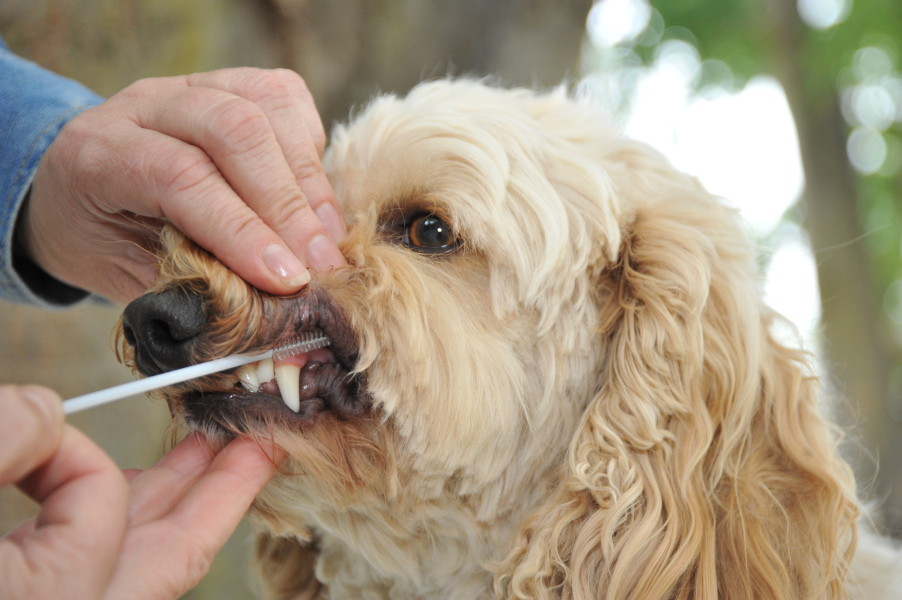Quick Summary
Click here for Price and Turnaround Time
Phenotype: Affected pups are born lacking hair on the forehead and back near the tail. Pups have a high frequency of eye infections prior to opening. Both teeth and secondary hair are either absent or abnormal. The mechanism for clearing matter from the respiratory tract (mucociliary clearance) is diminished, resulting in an increased susceptibility to pulmonary infections. Clinically, a lack of glands in affected dogs has been noted, including bronchial, tracheal, esophageal, and sweat glands.
Mode of Inheritance: X-linked recessive
Alleles: N = Normal/Unaffected, XHEDgs = X-linked hypohidrotic ectodermal dysplasia (German Shepherd variant)
Breeds appropriate for testing: German Shepherd Dog
Explanation of Results:
Males only have one X chromosome whereas females have two, therefore possible genotypes will differ by sex.
- Female dogs with N/N genoytpe and male dogs with N genotype will not have XHED, and cannot transmit this variant to their offspring.
- Female dogs with N/XHEDgs genotype will not have XHED, but are carriers. If a carrier female is bred to a normal male, all female puppies will be normal but 50% of them will be carriers. Among male puppies from this type of cross, 50% will be normal and 50% will be affected by XHED.
- Female dogs with XHEDgs/XHEDgs genotype and male dogs with XHEDgs genotype will have XHED.
Results of this test can be submitted to the OFA (Orthopedic Foundation for Animals)
German Shepherd Health Panel
$130 per animal
Sample Collection
Dog DNA tests are carried out using cells brushed from your dog's cheeks and gums. The preferred cytology brushes are sent to you by mail, or you may provide your own brushes. For accepted alternative brushes, click here
We recommend waiting until puppies are at least three weeks old before testing.

Step-By-Step:
- Make sure the dog has not had anything to eat or drink for at least 1 hour prior to collecting sample.
- When swabbing puppies, isolate each puppy from the mother, littermates and any shared toys for 1 hour prior to swabbing. Puppies should not have nursed or eaten for 1 hour prior to collecting sample.
- If collecting samples from more than one dog, make sure to sample one dog at a time and wash your hands before swabbing another dog.
- Label brush sleeve with name or ID of dog to be sampled.
- Open brush sleeve by arrow and remove one brush by its handle.
- Place bristle head between the dog’s gums and cheek and press lightly on the outside of the cheek while rubbing or rotating the brush back and forth for 15 seconds.
- Wave the brush in the air for 20 seconds to air dry.
- Insert brush back into sleeve.
- Repeat steps 5 - 8 for each unused brush in sleeve on a fresh area of cheek and gums. Make sure to use and return all brushes sent by the VGL. In most cases, it will be 3 brushes per dog. If using interdental gum brushes, please note that the VGL requires 4 brushes per dog and only moderate or wide interdental gum brushes are accepted.
- Do not seal brushes in sleeve.
- Place all samples in an envelope and return to the address provided.
ATTENTION:
- Do not collect saliva/drool – the key to obtaining a good sample is getting cheek cells on the swab
- Do not rub swab on the dog’s tongue or teeth – this will result in poor quality sample
- Do not collect a sample from a puppy that has recently nursed – the mother’s genetic material can rub off on the puppy’s mouth and contaminate the sample
X-linked hypohidrotic ectodermal dysplasia (XHED) is an inherited disorder that has been reported in several breeds and mixed-breed dogs. Affected pups are born lacking hair on the forehead and back near the tail. Pups have a high frequency of eye infections prior to opening. Both teeth and secondary hair are either absent or abnormal. The mechanism for clearing matter from the respiratory tract (mucociliary clearance) is diminished, resulting in an increased susceptibility to pulmonary infections. Clinically, a lack of glands in affected dogs has been noted, including bronchial, tracheal, esophageal and sweat glands.
Except for the German Shepherd Dog, the molecular basis of this defect in different breeds is unknown and likely results from different mutations. In German Shepherd Dogs, XHED deficiency results from a c.910-1G>A (reported as XHEDgs) mutation in the intron 8 splice acceptor site of ectodysplasin A (EDA) gene resulting in abnormal protein production. EDA is involved in the morphogenesis of hair follicles and tooth buds. The disease is inherited in an X-linked recessive fashion. Females with two copies of the affected allele will show disease. Clinical signs are absent in females with one normal and one affected gene (carriers). Males have only one X chromosome. If the inherited allele is affected, males will show disease. If the inherited allele is normal, the dog does not have the disease.
Testing for the German Shepherd form of XHED assists veterinarians with diagnosis of XHED and helps breeders identify carrier females among breeding stock to avoid mating pairs that can produce affected dogs. When a carrier female is bred to a normal male, all female puppies will be normal but 50% of them will be carriers. Among male puppies from this cross, 50% will be normal and 50% will be affected.
